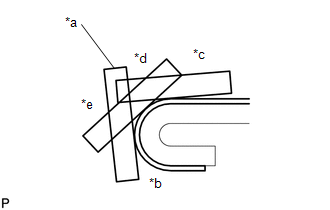Toyota CH-R Service Manual: Installation
INSTALLATION
CAUTION / NOTICE / HINT
HINT:
- Use the same procedure for the RH side and LH side.
- The following procedure is for the LH side.
PROCEDURE
1. REPAIR INSTRUCTION
(a) Clean the vehicle body surface.
(1) Using a heat light, heat the vehicle body surface.
Heating Temperature|
Item |
Temperature |
|---|---|
|
Vehicle Body |
40 to 60°C (104 to 140°F) |
CAUTION:
- Do not touch the heat light and heated parts, touching the heat light may result in burns.
- Touching heated parts for a long time may result in burns.
.png)
|
*a |
Heated Part |
|
*b |
Heat Light |
NOTICE:
Do not heat the vehicle body excessively.
(2) Wipe off any tape adhesive residue with cleaner.
(b) Installation temperature
(1) When the ambient temperature is below 15°C (59°F), perform the installation procedure after warming the vehicle body surface (installation surface of the door frame) and tape up to between 20 and 30°C (68 and 86°F) using a heat light. When the ambient temperature is above 35°C (95°F), cool the vehicle body surface (installation surface of the door frame) and tape down to between 20 and 30°C (68 and 86°F) prior to installation.
HINT:
- The most appropriate temperature for installing the tape is 25°C (77°F).
- When the temperature is low, the tape becomes stiff and comes off easily. When the temperature is high, the tape elasticity increases.
(c) Before installation
(1) Remove any coating roughness or dirt on and around the vehicle body surface where the tape will be installed (installation surface of the door frame). If any roughness or dirt remains when pressing the tape onto the surface, air will be trapped under the tape and result in a poor appearance.
HINT:
Spray water on the shop floor to settle any dust.
(d) Key points for handling the tape
(1) The tape bends and rolls up easily. Store the tape between flat pieces of cardboard or other similar objects and keep it dry and flat.
NOTICE:
Do not bend the tape or leave it in high temperature places.
(e) Key points for installation of the tape (How to use a squeegee and installation procedure for flat surfaces)
NOTICE:
- Position the tape accurately to achieve a neat finish and to avoid peeling.
- The tape cannot be reused because it deforms after removal.
(1) To avoid air bubbles, slightly raise the part of the tape that is going to be applied so that its adhesive surface does not touch the vehicle body prematurely. Tilt the squeegee at 40 to 50° (pressing forward) or 30 to 45° (pulling) to the vehicle body surface and press the tape onto the vehicle body surface with a force of 20 to 30 N (2 to 3 kgf, 4.5 to 6.7 lbf) at a constant slow speed of 30 to 70 mm (1.18 to 2.76 in.) per second.
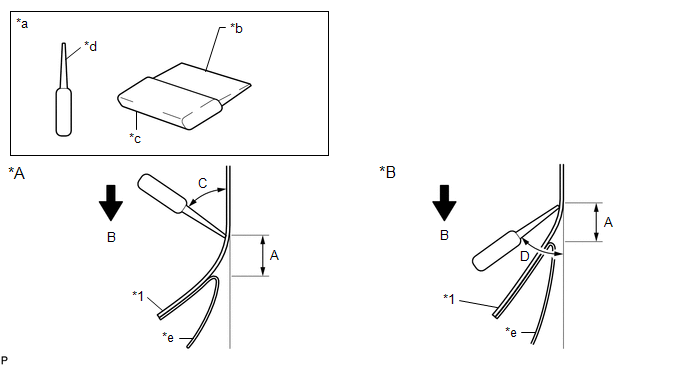
|
*A |
Pressing Forward |
*B |
Pulling |
|
*1 |
Black Out Tape |
- |
- |
|
*a |
Side View |
*b |
Non-padded Side |
|
*c |
Padded Side |
*d |
Squeegee |
|
*e |
Release Paper |
- |
- |
Standard Measurement:
|
Area |
Measurement |
Area |
Measurement |
|---|---|---|---|
|
A |
10 to 20 mm (0.394 to 0.787 in.) |
B |
30 to 70 mm/sec. (1.18 to 2.76 in./sec.) |
|
C |
40 to 50° (for pressing forward) |
D |
30 to 45° (for pulling) |
NOTICE:
Be sure to observe the specified pressing speed, force and angle of the squeegee to avoid wrinkles or air bubbles.
HINT:
- Either angle of the squeegee (pressing forward or pulling) is acceptable.
- Be sure to apply the tape while removing the release paper 10 to 20 mm (0.394 to 0.787 in.) from the edge of the squeegee.
(f) Key points for installation of the tape (How to use a squeegee and installation procedure for hemmed surfaces)
|
(1) If it is difficult to apply the tape, install it in several steps as shown in the illustration. Use your fingers or the padded surface of a squeegee to slowly apply the tape to the hem of the vehicle, especially for a small hem. HINT: When applying tape to the backside of a hem, remove the release paper and use your fingers or the padded surface of a squeegee. |
|
(g) Key points for installation of the tape (How to use a squeegee and installation procedure for corners)
(1) Remove the release paper and apply the tape carefully with your fingers.
(2) Before applying the tape to each corner, heat the tape using a heat light and gradually apply it, avoiding wrinkles on the tape to achieve a neat finish.
(h) Check after installation
(1) After completing the installation, check if the tape is installed neatly. If the tape is not installed neatly, install a new tape.
NOTICE:
Do not reuse the tape.
2. INSTALL NO. 2 FRONT DOOR STRIPE
(a) Refer to the illustration to position a new No. 2 front door stripe.
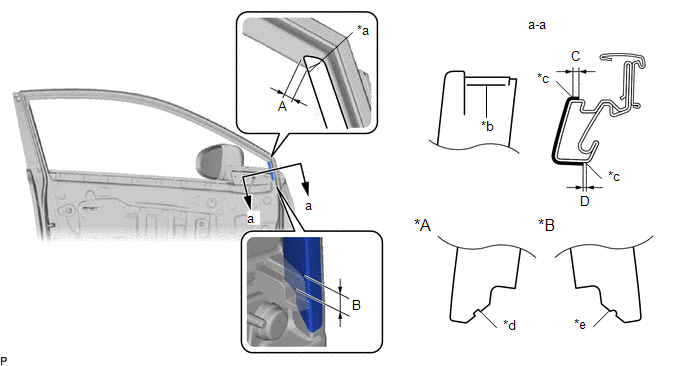
|
*A |
LH Side |
*B |
RH Side |
|
*a |
Point A |
*b |
Point B |
|
*c |
Edge of Curved Surface |
*d |
Square |
|
*e |
Round |
- |
- |
Standard Measurement:
|
Area |
Measurement |
Area |
Measurement |
|---|---|---|---|
|
A |
4.0 mm (0.157 in.) |
B |
5.0 mm (0.197 in.) |
|
C |
2.5 mm (0.0984 in.) |
D |
1.0 mm (0.0394 in.) |
(b) Remove the release paper and install the No. 2 front door stripe.
HINT:
Align the point (B) on the No. 2 front door stripe with the point (A) on the door frame and install the No. 2 front door stripe.
3. INSTALL FRONT DOOR OUTSIDE STRIPE
(a) Refer to the illustration to position a new front door outside stripe.
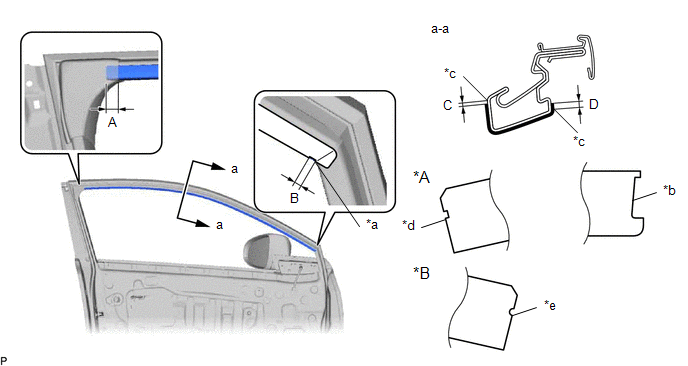
|
*A |
LH Side |
*B |
RH Side |
|
*a |
Point A |
*b |
Point B |
|
*c |
Edge of Curved Surface |
*d |
Square |
|
*e |
Round |
- |
- |
Standard Measurement:
|
Area |
Measurement |
Area |
Measurement |
|---|---|---|---|
|
A |
10.0 mm (0.394 in.) |
B |
4.0 mm (0.157 in.) |
|
C |
1.0 mm (0.0394 in.) |
D |
2.5 mm (0.0984 in.) |
(b) Remove the release paper and install the front door outside stripe.
HINT:
Align the point (B) on the front door outside stripe with the point (A) on the door frame and install the front door outside stripe.
4. INSTALL NO. 4 FRONT DOOR STRIPE
(a) Refer to the illustration to position a new No. 4 front door stripe.
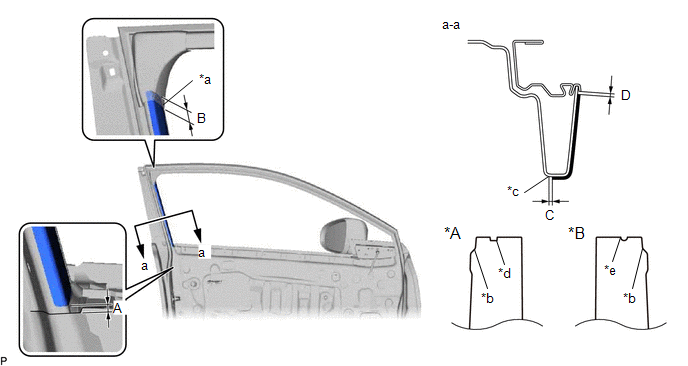
|
*A |
LH Side |
*B |
RH Side |
|
*a |
Point A |
*b |
Point B |
|
*c |
Edge of Curved Surface |
*d |
Square |
|
*e |
Round |
- |
- |
Standard Measurement:
|
Area |
Measurement |
Area |
Measurement |
|---|---|---|---|
|
A |
3 mm (0.118 in.) |
B |
10.0 mm (0.394 in.) |
|
C |
1.0 mm (0.0394 in.) |
D |
-1.0 to 1.0 mm (-0.0394 to 0.0394 in.) |
(b) Remove the release paper and install the No. 4 front door stripe.
HINT:
Align the point (B) on the No. 4 front door stripe with the point (A) on the door frame and install the No. 4 front door stripe.
5. INSTALL FRONT DOOR FIX WINDOW GLASS
Click here
.gif)
.gif)
.gif)
6. INSTALL FRONT DOOR FRONT LOWER FRAME SUB-ASSEMBLY
Click here
.gif)
.gif)
.gif)
7. INSTALL FRONT DOOR GLASS RUN
Click here
.gif)
.gif)
.gif)
8. INSTALL DOOR FRAME UPPER GARNISH
Click here
.gif)
.gif)
.gif)
9. INSTALL FRONT DOOR GLASS SUB-ASSEMBLY
Click here
.gif)
.gif)
.gif)
10. INSTALL FRONT DOOR SERVICE HOLE COVER
Click here
.gif)
.gif)
.gif)
11. INSTALL OUTER REAR VIEW MIRROR ASSEMBLY
Click here
.gif)
.gif)
.gif)
12. INSTALL FRONT DOOR VENT SEAL
Click here
.gif)
.gif)
.gif)
13. INSTALL FRONT DOOR GLASS INNER WEATHERSTRIP
Click here
.gif)
.gif)
.gif)
14. INSTALL FRONT DOOR BELT SEAL
Click here
.gif)
.gif)
.gif)
15. CONNECT FRONT DOOR WEATHERSTRIP
Click here
.gif)
.gif)
.gif)
16. INSTALL FRONT DOOR LOWER FRAME BRACKET GARNISH
Click here
.gif)
.gif)
.gif)
17. INSTALL FRONT DOOR TRIM BOARD SUB-ASSEMBLY
Click here
.gif)
.gif)
.gif)
18. INSTALL MULTIPLEX NETWORK MASTER SWITCH ASSEMBLY WITH FRONT ARMREST BASE UPPER PANEL (for Driver Side)
Click here
.gif)
.gif)
.gif)
19. INSTALL POWER WINDOW REGULATOR SWITCH ASSEMBLY WITH FRONT ARMREST BASE UPPER PANEL (for Front Passenger Side)
Click here
.gif)
.gif)
.gif)
20. INSTALL FRONT DOOR INSIDE HANDLE BEZEL PLUG
Click here
.gif)
.gif)
.gif)
21. CONNECT CABLE TO NEGATIVE BATTERY TERMINAL
Click here
.gif)
NOTICE:
When disconnecting the cable, some systems need to be initialized after the cable is reconnected.
Click here
.gif)
.gif)
.gif)
22. INITIALIZE POWER WINDOW CONTROL SYSTEM
Click here
.gif)
23. INSPECT POWER WINDOW OPERATION
Click here
.gif)
.gif)
 Removal
Removal
REMOVAL
CAUTION / NOTICE / HINT
The necessary procedures (adjustment, calibration, initialization or registration)
that must be performed after parts are removed and installed, or replaced during ...
Other materials:
Toyota CH-R Service Manual > Blind Spot Monitor System: Open in Outer Mirror Indicator(Slave) (C1AB5)
DESCRIPTION
This DTC is stored when the blind spot monitor sensor RH (Slave) detects an open
in the outer rear view mirror indicator RH.
DTC No.
Detection Item
DTC Detection Condition
Trouble Area
C1AB5
Open in Outer Mirror ...
Toyota CH-R Service Manual > Hood Lock Control Cable Assembly: Components
COMPONENTS
ILLUSTRATION
*1
FRONT FENDER LINER LH
*2
NO. 1 RADIATOR GRILLE RETAINER
*3
NO. 1 RADIATOR TO SUPPORT SEAL
-
-
ILLUSTRATION
*A
w/ Engine Hood Courtesy Switch ...
Toyota C-HR (AX20) 2023-2025 Owner's Manual
Toyota CH-R Owners Manual
- For safety and security
- Instrument cluster
- Operation of each component
- Driving
- Interior features
- Maintenance and care
- When trouble arises
- Vehicle specifications
- For owners
Toyota CH-R Service Manual
- Introduction
- Maintenance
- Audio / Video
- Cellular Communication
- Navigation / Multi Info Display
- Park Assist / Monitoring
- Brake (front)
- Brake (rear)
- Brake Control / Dynamic Control Systems
- Brake System (other)
- Parking Brake
- Axle And Differential
- Drive Shaft / Propeller Shaft
- K114 Cvt
- 3zr-fae Battery / Charging
- Networking
- Power Distribution
- Power Assist Systems
- Steering Column
- Steering Gear / Linkage
- Alignment / Handling Diagnosis
- Front Suspension
- Rear Suspension
- Tire / Wheel
- Tire Pressure Monitoring
- Door / Hatch
- Exterior Panels / Trim
- Horn
- Lighting (ext)
- Mirror (ext)
- Window / Glass
- Wiper / Washer
- Door Lock
- Heating / Air Conditioning
- Interior Panels / Trim
- Lighting (int)
- Meter / Gauge / Display
- Mirror (int)
- Power Outlets (int)
- Pre-collision
- Seat
- Seat Belt
- Supplemental Restraint Systems
- Theft Deterrent / Keyless Entry
0.0076

